Diamonds are awesome and their brilliant sparkle has captured the hearts and imaginations of people for centuries.
And whether you are in the market for a diamond engagement ring, a gift for a loved one, or simply want to add to your jewellery collection, navigating the world of diamond buying can be overwhelming.
This is because there are a number of factors to consider when choosing the perfect diamond and it can be difficult to know where to begin.
And it is for this reason that I created a diamond buying guide, that will walk you through everything you need to know to make an informed and confident purchase, whether you’re a seasoned diamond buyer or a complete novice.
So let’s get started and explore the fascinating world of diamonds together.
1. Diamond Quality Factors
Before we get into the buying process we are going to look at the quality factors that impact on the value of Diamond as this will give you a better understanding of what to look for when buying a Diamond and the terminology that is used.
I’m not saying you don’t need to become an expert but you want to learn about the basics and I’ll cover the important ones below
If you want to learn more, I’d recommend reading my Introduction to Diamonds guide, which covers all of the aspects mentioned above and more.
The 4 C’s
The 4 C’s are the grading criteria used to assess the quality of a diamond and understanding what these are an important part of the diamond buying process.
Colour
This is the body colour of the stone and most white diamonds (they are actually colourless but are called white) are graded using the GIAs (Gemological Institute of America) colour grading scale and this ranges from D, which is colourless to Z which has a strong tint of yellow but generally stones in the M-Z colour range are referred to as tinted stones.

The human eye only starts seeing the tint at around the H colour but this is very faint and only really obvious when compared to a stone with a higher colour grade.
If you are looking at fancy colour diamonds such as Pink’s, Blue’s or Yellow’s, these are graded differently and it is based on the hue, tone and saturation.
Clarity
This is how free from inclusions the diamond is and some people may refer to clarity as to how clean the stone is to the eye, once again the GIAs grading criteria is the most popular and it ranges for Flawless to Included.

Clarity is one of the things many buyers seem to obsess over as they want the cleanest stone they can afford but just because a stone has a good clarity grade doesn’t mean it is attractive to look at.
I have seen many SI1 and SI2 stones where the inclusion is small and not obvious that look amazing and I’ve seen VS and even VVS stones that don’t really catch the eye, which is why it is always best to see the stone before making a purchase.
Cut
I would say this is the most overlooked and misunderstood of the 4 C’s as many people think that this is the shape of the stone but it isn’t, it is the quality of the cut.
And this is an important one as the quality of the cut can have a big impact on the appearance of the diamond, especially for any of the brilliant cut diamond as a poorly cut stone can often look dull and lifeless.
When it comes to the quality of the cut, they are assessed on three factors:
- Proportions
- Symmetry
- Polish
And each factor is graded from poor to excellent, with diamonds graded excellent for all three being referred to a triple x stones but this isn’t a guarantee that they will look great to the naked eye and once again, it is best to see the stone in person before making a purchase.
Carat
This is the easiest one of the three and Carat is the unit of measurement that is used to weigh a diamond and 1 carat is the equivalent of 0.2 grams.
The important thing to be aware of when it comes to weight is that the price per carat increases with the weight, especially when you pass certain thresholds, for example a 1.01 carat diamond will cost a lot more per carat than a 0.97 carat diamond of the same style and quality, even though they appear to be the same size to the naked eye.
Fluorescence
Some diamonds exhibit a phenomenon called fluorescence and this causes the stone to glow when exposed to ultraviolet light and this reaction ranges from faint to strong.
And there are many people in the industry that wrongly think that fluorescence is a bad thing and should be avoided but the only time it is a bad thing is when it gives the stone a milky appearance because this obviously impacts on the look of the stone.
But in the majority of diamonds, fluorescence doesn’t have any impact on the look of the stone.
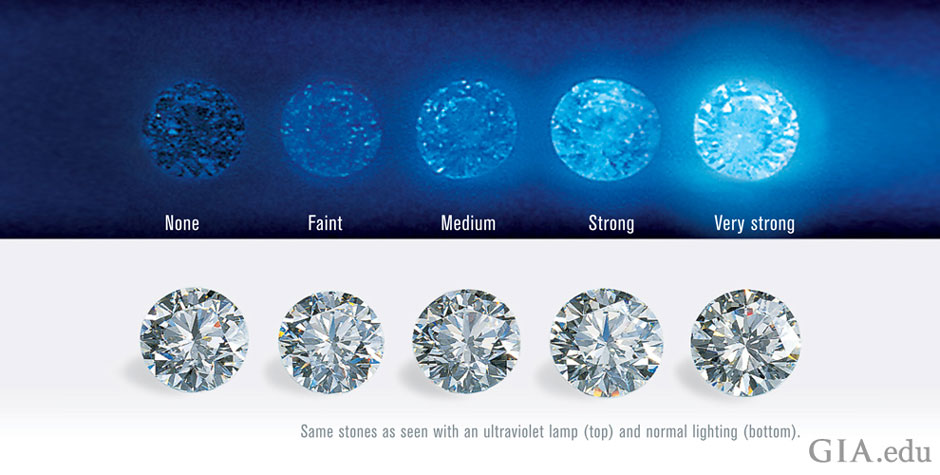
Treatments
Treated diamonds aren’t that common in the UK market but you still need to be aware of them and there are two main reasons why diamonds are treated.
To Reduce to Visibility of Inclusions
Diamonds with obvious inclusions such as black spots or fractures are treated reduce to appearance of these inclusions, with the two most common treatments being:
- Laser Drilling – this is where they use a laser to drill down to a dark inclusions and then either burn away or bleach the inclusion so that it is not as obvious
- Fracture Filling – this is where they fill surface reaching fracture with a high lead content glass to reduce their appearance, this can sometimes be done after a stone has been laser drilled
I would avoid either of these, especially fracture filling as when exposed to head the glass can be removed from the fracture.
To Alter the Colour
This is becoming a more popular treatment of diamonds and there are different forms of treatment that can alter the colour but it is usually done to achieve one of two outcomes:
- Improving the colour of the stone – some natural brown diamonds can be HPHT treated (high pressure, high temperature, which mimics what happens in nature) to make them colourless
- Change the colour – there are many fancy colour diamonds that have been treated to produce the colour in the stone and these are usually significantly cheaper than naturally colour diamonds
I would always recommend buying a stone that has been coloured naturally but if the stone is cheap enough and you like it, they can be an interesting choice and with most fancy colour treated diamonds, the colour is stable (meaning it won’t change over time).
Diamond Reports
Another factor that impacts the price of a diamond is whether they are accompanied by a report or not and where this report is from.
But diamond reports are often described as certificates and you will often see something along the lines of ‘certified diamonds’ but this isn’t correct as there is a difference between these two types of documents:
- A Report – gives information about a subject, in this case, a Diamond but it is the opinion of the person grading the stone as to the colour, clarity etc
- A Certificate – a document that states that the information on it is true
Without getting too technical, Diamond grades for things such as colour and clarity don’t have defined boundaries and it is the opinion of the person who is assessing the stone as to which grade the stone is given.
And this is why all reputable gem labs, such as the GIA only provide reports and if you see that a Diamond has a certificate of authenticity, run away as fast as you can!
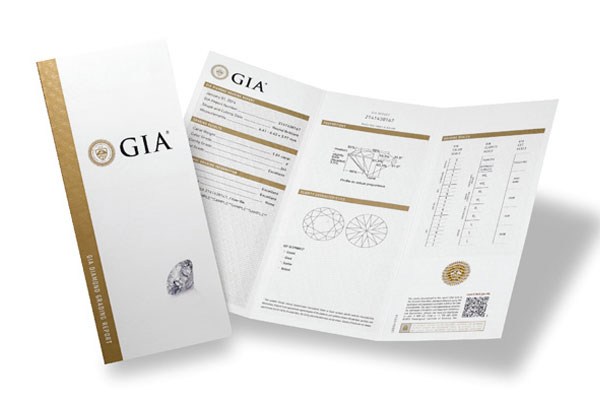
When it comes to price, a Diamond with a report will be more expensive than the same quality stone that doesn’t have a report.
Reports from different gem labs also attract different premiums and a diamond with a GIA report will be more expensive than the same quality stone with an IGI report due to GIA having a better reputation.
2. The Diamond Buying Guide
Step 1: Set Yourself a Budget
I honestly can’t stress this one enough as setting a budget makes the whole process so much easier and it doesn’t matter whether your budget is £500 or £500,000, make sure to let the person you are buying from know.
This helps them tailor the piece to your budget because going in and saying something like “I don’t really have a budget” means that they have to do some detective work to find out how much you have to spend because Diamonds can range from less than $1000 a carat to millions of dollars a carat.
There are also other things you need to consider when setting your budget as it is very rare that someone just buys a Diamond, usually it is being bought to go in a piece of jewellery, so your budget needs to cover:
- The Diamond
- The Mount (the piece of jewellery in which the stone is going to be set)
- Cost of setting the Diamond and finishing the mount
And by letting them know what your budget is, they can then make recommendations based on this, which is results in my more enjoyable experience.
A common mistake many people buying engagement rings make is to not spend too much money on the mount, instead spending most of the budget on the stone.
But this can be false economy as a poor quality mount (usually a mass-produced casting), might not last all that well when being worn every day and it may require regular repairs or worse, the stone falling out.
Instead, for engagement rings, it is often best to go for a high-quality, handmade mount as this will generally last a lot better than an equivalent cast piece.
Now that you know a little more about diamonds, lets take a look at the process of buying one…
Step 2: Buy From a Reputable Source
Choosing where the buy your diamond is a big part of the buying process and you want to by from a reputable company, of which there are many options, including:
- Independent designer makers
- Independent jewellery consultants
- Independent retailers, these can be online or have a retail outlet
- High street or chain jewellers
My personal recommendation is to deal with smaller, independent companies as you will often get a better quality product, get a better and more personalised service and in many cases get better value for money than you would from large companies.
But how do you find these awesome independent businesses?
- Word of mouth – nothing is better than getting a recommendation from someone who has dealt with them before
- Reviews – pretty much every business will have some reviews online, these may be on Google, Facebook or an independent review site
- Trade organisations – many organisations will have a list of members but I would always look for reviews for any that you are interested in
My final piece of advice is to go with your gut, if you go somewhere and something doesn’t feel right then walk away and find someone you feel happy dealing with.
Step 3: Lab-grown vs Mined Diamonds
Choosing the origin of a diamond is now an important step of the buying process and it is down to personal preference as to which one you choose but I would recommend doing research into this (I plan on doing a post on this in the future) and look at things like:
- Environmental & sustainability claims
- The socio-economic impact of where the diamonds come from
This is because there is a lot of misinformation out there, along with a lot of unverified claims, especially around lab-grown diamonds and the marketing material that the manufacturers and retailers are using.
There are pros and cons to both types and as I said, it is personal preference as to which one you go for but there is one thing that you do need to be aware of and that is that natural diamond prices generally quite stable (and of increase over time) due to a finite supply where as lab-grown diamonds pricing are falling.
For example, a 1ct round brilliant, VS clarity near colourless diamond:
- Natural Diamond – just over $6000 a carat in 2016 to just under $6000 a carat in 2022
- Lab-grown Diamond – over $5000 a carat in 2016 to under $2000 a carat in 2022
And lab-grown diamond are likely to decrease further in price due to increased supply and reduced costs of producing them according to data by Paul Zimnisky.
It can be useful to learn is the different terminology that is used around these two types of Diamonds:
- Lab-grown Diamonds
- Laboratory grown Diamonds
- Synthetic Diamonds
- Man-made Diamonds
- Natural Diamonds
- Earth mined Diamonds
- Mined Diamonds
Step 4: Choose a Style of Cut
The next step in the buying process is to choose the style of cut that you want for your diamond and once again this will be down to personal choice.
The most popular cut for diamonds is the Round Brilliant but there are quite a few different styles of cut to choose from and the majority fall into one of two categories, which are brilliant and step cuts.

Brilliant Cuts
All of the modified brilliant cuts are based off the Round Brilliant, which is a style of cut that has been studied and perfected over the years to produce the maximum sparkle.
Variations of the Round Brilliant include the Oval, Pear, Princess and Radiant and it is this type of cut that you want to go for if you want a diamond that sparkles.

Oval Cut

Pear Cut

Princess Cut

Radiant Cut
Step Cuts
The step cut is another popular style of cut but these generally don’t have the same levels of sparkle as that of the brilliant cuts due to the way the diamonds are cut but the benefit of this is that step cuts usually have very few inclusions as the can’t be hidden as easily as they can with brilliant cuts.
The most popular styles of the step cut are the Emerald, Baguette and Asscher.

Emerald Cut
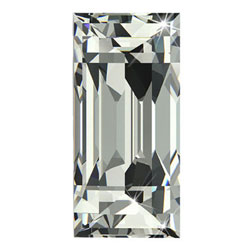
Baguette Cut

Asscher Cut
When it comes to choosing a style of cut, more popular styles will have a higher price per carat than a less desirable cut. For example a 1ct G/VS Round Brilliant will have a higher price per carat than a 1ct G/VS Heart Cut.
Step 4: Choose a Setting Style
Once again, this is a personal preference and it also depends on the piece of jewellery that the diamond is going to be set into.
But in general, there are two settings styles that are popular for diamonds and they are claw (sometimes called prongs) or bezel.
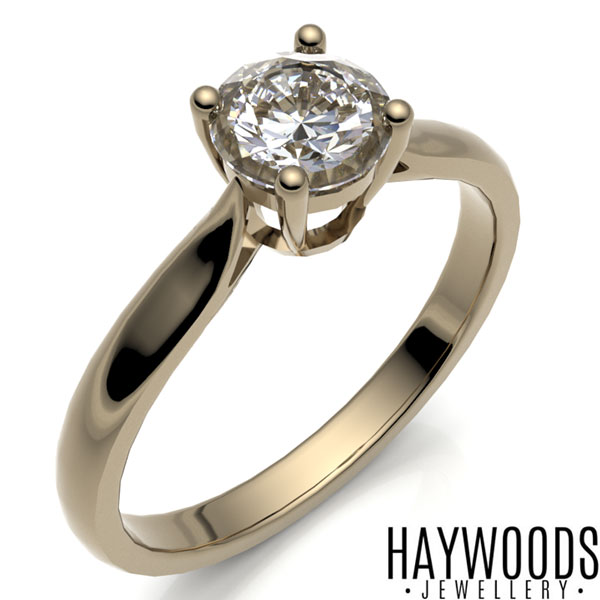
4 Claw Diamond Solitaire
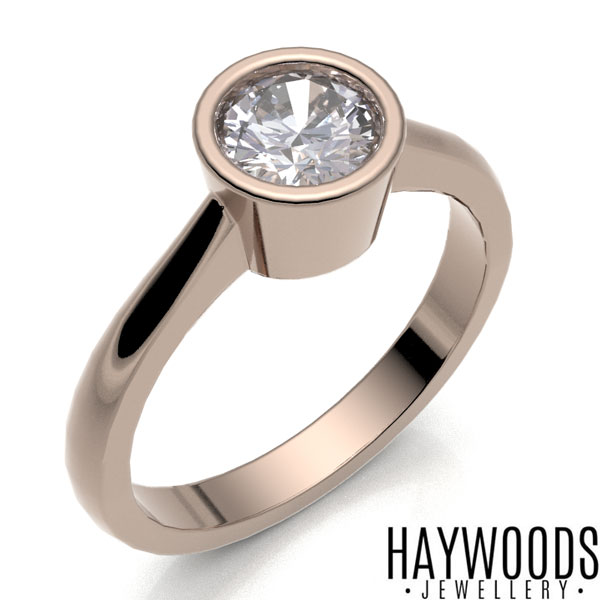
Full Bezel Diamond Solitaire
And while it is personal preference, there are pros and cons to both styles of setting.
With Claw Settings, they let more light into the stone, which can make them look brighter and give them more ‘life’ but the downside is that the claws can become loose over time, especially if they get caught on something such as clothing.
Which is why they need to be checked regularly (every 1-2 years) to make sure they are tight to prevent you from losing the diamond and for larger diamonds (half a carat+), it is often better to have 6 or more claws rather than 4 as they secure the stone better and there is less chance of losing the stone.
Bezel setting is one of the most secure forms of setting as there is metal securing the whole stone but depending on the style of the bezel, they can make the stone look duller than it does when loose.
Many of the setting styles that are available are modifications of these two and you want to choose a style that looks good but is also secure and protects the stone, especially stones with points as these are the weakest points of the stone.
Step 5: See The Diamond for Yourself
This is something people are doing less of, especially with the growth of online retailers for both loose diamonds and finished jewellery but the problem with many of these outlets are they have tried to make Diamonds a commodity in a similar way to Gold or Silver but this simply isn’t possible because every Diamond is different and will have its own characteristics.
And this is why I can’t stress enough that you need to see the Diamond for yourself and not just buy off the report as there are stones which look great on paper but are dull and lifeless in real life and stones that don’t look great on the report but are full of life and sparkle when seen in person.
This is where visiting a true Diamond specialist can be a worthwhile experience as they will let you view the stones for yourself and will often provide you with some helpful tips and advice around choosing a Diamond.
It is also the case with many Diamond specialists that they are very selective when choosing the stones they stock and show to prospective clients as they only want to have stones that have the ‘wow’ factor.
And what happens with many people is that there is one stone that just stands out from the rest (I have this when buying from dealers) and you often can’t explain why but it just catches your eye more than any of the others and if that happens, then you have found your perfect diamond.
Conclusion
And I know that buying a Diamond can be a scary and intimidating process, I experienced it when buying an engagement ring and the first time I visited a diamond dealer for my business but with a little bit of knowledge and a plan in place, it can be an awesome and enjoyable experience (I now love going to look at diamonds!)
And honestly, buying a Diamond should be treated in a similar way you would (or should!) any other major purchase, especially for an engagement ring by:
- Having a clear budget
- Having an idea of what you want to buy before you go looking
- Finding the right place to buy from
Then you shouldn’t go far wrong and will hopefully end up with the perfect Diamond, whether for yourself or that special person in your life.
I'm Paul Haywood FGA DGA, a fully qualified Gemmologist and Diamond Grader from the Gemmological Association of Great Britain and a lover of all things jewellery.
